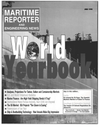
Page 78: of Maritime Reporter Magazine (June 1998)
Read this page in Pdf, Flash or Html5 edition of June 1998 Maritime Reporter Magazine
Hempel Coatings Offers
Hempadur 17630
Hempadur 1763 from Hempel Coatings is a high-build, light-colored modified epoxy paint for the application of cost-effective sys- tems in new ships. It does not contain tar or isocynate, and has a low content VOC.
Hempadur 17630 is specified as a two-coat system in accordance with widely accepted guidelines for ballast tank coating systems. It cures down to 0°C/32°F, making it a all- year-round product in most locations. The light color makes inspections easier.
Hempel Coatings (USA) is part of the worldwide Hempel Organization, which was founded in 1915 in Denmark. The Hempel
Group is owned by the J.C. Hempel
Foundation, and Hempel is reportedly the largest independent paint and coatings com- pany in the world. The company is a leader in the field of marine coatings, providing products for both new construction and repair jobs. Its product line is complete with ballast tank coatings designed to comply with 1998 SOLAS regulations, cargo holding coatings that are made for strength and economy, and Combic and Olympic anti- fouling systems.
Circle 26 on Reader Service Card ity could be adjusted by thinning; now the applicators must learn to use the correct nozzle tip and pres- sure. The new HAPs regulations require that the quantities of thin- ner emitted be monitored, as well as the solvent in the can.
Applicators and supervisors must also be trained on the procedures for recordkeeping and inventory control.
Recordkeeping and Quality
Control
One of the major effects of the new regulations has been the requirement for the yard to keep detailed records of the quantity and type of VOC emitted.
Newport News Shipbuilding (Newport News, Va.) uses a com- puter program which enables the yard to track, on a daily basis, the amount of paint applied at each of the several dock area where paint is applied.
Electric Boat also tracks the paints and thinners from when they are received through final application. As major sources, both of these yards are limited in total emissions per year as noted above. The state of Connecticut also mandates additional emission limitations and reporting require- ments on Electric Boat for adhe- sives that contain VOCs.
Scott Devinney of Bath Iron
Works has pointed out that the shipyards are still liable for any penalty from environmental viola- tions. He advises the yards to peri- odically spot check the VOCs and
HAPs levels reported by manufac- turers. As part of the yard*s quali- ty control, Bath Iron Works identi- fied several chlorinated alkyds whose VOCs exceeded the EPA limits, as well as the manufactur- ers own product data sheets.
The Navy relies on its procure- ment agent (GSA) to check the con- formance of the coating to the
Navy specification requirements, including the VOC. GSA also relies primarily on the data from the manufacturers.
EPA Estimates of Impact
EPA estimated the annual cost of the national HAPs regulation from the 35 major source shipyards at approximately $2 million. The agency also expected virtually no capital costs associated with this regulation. For the VOC rule imposed by state and local regula- tory agencies, EPA estimates nationwide costs of approximately $1.1 million per year. The total estimated cost is, therefore, $3.1 million per year. These numbers are very hard to quantify; they depend on the methodology, the base year, and other factors.
The HAPs rule is expected to reduce emissions of air toxics, including xylene and toluene, by 318 tons (350 tons) per year, repre- senting about a 24 percent reduc- tion from current levels. The VOC rule is expected to affect about 100 facilities, and reduce the emissions of VOCs by approximately 1,250 tons (1,380 tons) per year, so the total reductions are estimated at 1,570 tons (1,730 tons) per year.
Technology Adequate
Because of major R&D and test- ing initiatives by the coating man- ufacturers over the last 20 years, coatings technology is more than
Circle 273 on Reader Service Card
Accurate, clear and constantly updated, Admiralty Charts and
Publications have helped thousands of ocean-going vessels reach their destinations safely and reliably for over 200 years. And using the latest digital technology, it's a maritime tradition we're taking into the new millennium.
Admiralty navigational infor- mation extends worldwide - just like our distribution network.
So you're never far away from charts you can totally depend on - whatever your port of call.
For more information, call your nearest Chart Agent, or contact
The United Kingdom Hydrographic
Office on +44 (0)1823 337900.
WHEN YOU'RE SAILING THE WORLD'S
OCEANS YOU WANT THE WORLD'S
MOST RELIABLE NAVIGATIONAL
INFORMATION
DMIRALTY "J
June, 1998 80

 77
77

 79
79
